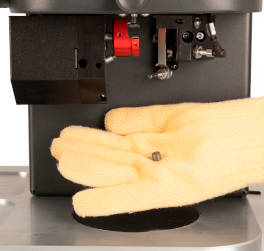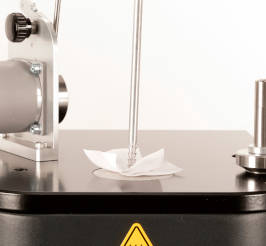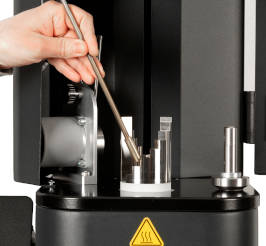A melt flow index tester requires regular maintenance to deliver repeatable and accurate results over time. Here we look at four maintenance top tips to maximize an Instron melt flow tester’s uptime and efficiency. This way, you can make the most of your melt flow index tester, minimizing downtime and total cost of ownership.
1. Clean Regularly and Thoroughly
Cleaning is at the heart of a melt flow tester's day-to-day maintenance routine. The ISO 1133 and ASTM D1238 standards require a melt flow index instrument to be cleaned at the end of each test.
During a melt flow index test, a piston forces a sample of molten material into a barrel through a die. Following the test, you must remove any residue to ensure repeatable results over time.
Residue can cause friction, affecting the accuracy of results. It may also degrade over time with unpredictable consequences. For example, the material may harden, causing unwanted friction and leading to a lower-than-expected melt flow index. In other circumstances, the residue may liquefy and generate excessive lubrication, causing an overestimation of the melt flow rate.

The latest Instron melt flow tester technology makes cleaning easier and faster. You can easily remove the die from the bottom to quickly perform all the necessary cleaning operations at the end of each test.
Cleaning piston, die, and barrel regularly is essential. But, often, it is not enough. You must also clean each part thoroughly. Always perform a visual inspection of the barrel to ensure that all surfaces are clean. The barrel's internal walls are mirror-like, making it easy to spot any residue.

Using the correct cleaning tools is also essential. Excessive cleaning, abrasive brushes, and harsh detergents can wear down the piston over time, shortening its lifespan and resulting in downtime and costs. Select a melt flow tester with an integrated cleaning device*. This way, you can ensure that the size and characteristics of the cleaning tools suit your testing machine.
2. Keep One Step Ahead of Faults
A preventative maintenance schedule can help ensure that each melt flow tester component stays within the tolerances imposed by ISO 1133 and ASTM D1238. There are different types of checks you should perform regularly. The frequency of these checks may vary depending on the melt flow tester model and its applications. Generally, the more frequently you operate the machine, the more often you should perform checks.
The fundamental checks to perform – in order of frequency - are:
- Die tolerance check – This is the so-called “Go/No-Go gauge” that measures the inner diameter of the die to ensure it complies with the ISO 1133 and ASTM D1238 requirements.
- Piston tolerance check – Again, a “Go/No-Go gauge” check determines whether the piston remains compliant over time
- Barrel checks – Typically recommended when using a melt flow tester intensively and/or when testing particularly abrasive materials. This type of check is more complex than the previous two and can only be performed by trained personnel in a lab environment.

Besides the above checks, regular temperature checks – performed using an appropriate electronic thermometer - are just as important. They ensure that the declared temperature always matches the actual temperature reached during testing, minimizing the risk of obtaining inaccurate results.
When planning a preventative maintenance schedule, always consider the total cost of ownership. The cost of the necessary equipment adds to the investment in training and/or hiring maintenance personnel, not to mention the costs associated with machine downtime.

Always consider relying on a trusted supplier that can offer a preventative maintenance and calibration service.
3. Work Smarter, Not Harder
As we already mentioned, using the correct cleaning tools is paramount, and there is no one-size-fits-all solution. Opting for a melt flow tester with an integrated cleaning device* eliminates the risk of using the wrong tools. Not only that.
The latest semi-automatic melt flow tester solutions enable you to control all cleaning operations via an intuitive touch-screen interface. This way, the machine assists you every step of the way. All you have to do is position the device correctly and press a button while the machine takes care of performing the actual cleaning work.
4. Know Your Materials
Identifying a reference material can help monitor the consistency and accuracy of results over time. For example, when dealing with different compounds, you could select a base material used across all these compounds. By testing a sample of this reference material regularly, you can ensure that there are no significant variations in results that may point to calibration faults or wear-and-tear issues.
As the volume and variety of materials undergoing melt flow index testing continue to evolve, maintaining a high level of accuracy and repeatability has never been so important. For example, recycled materials are, by definition, the result of previous processing and are already partially degraded. When dealing with these materials, cleaning regularly and thoroughly is key to keeping the machine up and running and accurate over time.
Maintenance plays a pivotal role in the life of a melt flow index tester. Keeping an Instron melt flow tester clean and within the tolerances imposed by the industry standards is paramount. This way, you can extend the machine's lifespan, reduce your total cost of ownership, and safeguard repeatability and accuracy over time.
For more information about Instron’s melt flow index tester solutions visit the MFi Series page.
*MFi Series with automated cleaning system is not avalable for sales in Europe.